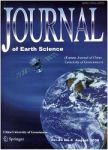New Conceptual Fold-Fracture Model Including Prefolding Fractures,Based on Fuyang-Lin'an Anticline,Zhejiang Province
New Conceptual Fold-Fracture Model Including Prefolding Fractures,Based on Fuyang-Lin'an Anticline,Zhejiang Province作者机构:Department of Earth Sciences Faculty of Land Resource Engineering Kunming University of Science and Technology Department of Earth Sciences Zhejiang University Research Center for the Structures in Oil and Gas Bearing Basin Ministry of Education Department of Architecture City College Kunming University of Science and Technology
出 版 物:《Journal of Earth Science》 (地球科学学刊(英文版))
年 卷 期:2014年第25卷第5期
页 面:901-911页
核心收录:
学科分类:070904[理学-构造地质学] 0709[理学-地质学] 07[理学]
基 金:supported by the Major National Science and Technology Programs in the "Twelfth Five-Year" Plan period (No. 2011ZX05009-001) Yunnan Provincial Training Project (No. KKSY201321058)
主 题:folding fracturing sequence model finite-element.
摘 要:Field observations of the crossing relationships of fractures have been used to explain the sequence of fractures. Based on field observations from Fuyang-Lin'an anticline, located near Hangzhou, Zhejiang Province, this paper proposes that the formation of synfolding fractures was influenced dominantly by one fracture set, which developed prior to folding and the orientation was nearly parallel to the bedding. The length of the prefolding fractures is longer than the synfolding fractures. These prefolding fractures cut thicker strata into small pieces and form a dense network of fractures in thicker strata. Most synfolding fractures, which are oblique to the bedding, are truncated by prefolding fractures in thicker strata. The synfolding fractures, which result from local stress, are inferred to form during folding. Here, the mechanism of truncation was analyzed using finite-element models. The approach was based on the idea that natural fractures can be interpreted or inferred from stress distribution. The presence or absence of prefolding fractures is shown to strongly control the distribution of stress, and this control has an important implication for interpreting the fracture truncation mechanism from geomechanical models.



